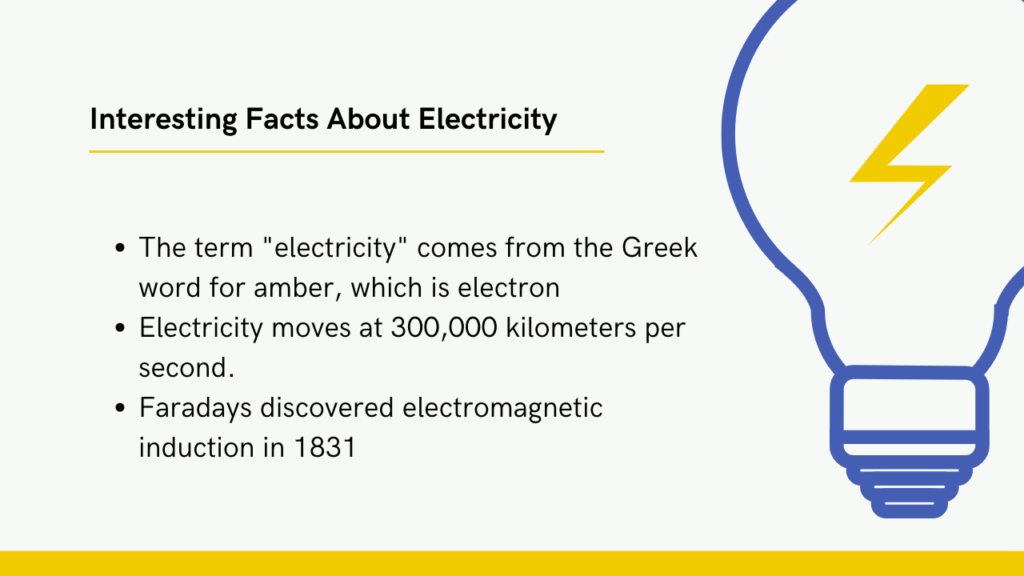
We all use electricity every day, but how much do you really know about it? Here are 10 interesting facts about electricity that you may not have known.
- The term “electricity” comes from the Greek word for amber, which is electron. Amber is a fossilized tree resin that can produce static electricity when it is rubbed.
- The first person to ever use the word “electricity” was English scientist William Gilbert. He published a book in 1600 called De Magnete, in which he discusses the magnetic properties of amber.
- Italian physicist Alessandro Volta is credited with inventing the first battery in 1800. His device, called a voltaic pile, was made up of a stack of alternating zinc and copper disks.
- Volta’s invention paved the way for others to experiment with electricity. In 1827, Georg Ohm discovered that there was a relationship between electric current and resistance. This discovery is now known as Ohm’s Law.
- It’s incredible to think about how fast electricity moves – 300,000 kilometers per second! This is why electrical shock or electrocution can occur so quickly. When electricity comes into contact with our bodies, it causes an electric current that can disrupt the normal functioning of our cells. This can lead to tissue damage and even death.
- Faradays discovered electromagnetic induction in 1831, which led to the development of the transformer and eventually the AC power grid that we use today.
- James Clerk Maxwell, a Scottish physicist, unified electricity and magnetism into one theory in 1865. Maxwell’s equations are still used by engineers today.
- Nikola Tesla was responsible for some of the most important electrical inventions of the late 19th and early 20th centuries. These inventions include alternating current (AC) power, radio transmission, and fluorescent lighting.
- Guglielmo Marconi sent the first radio signal across the Atlantic Ocean in 1901. His message consisted of just three words: “one…two…three.”
- Warren de La Rue and Joseph Swan made the lightbulb concept. And in 1879, Thomas Edison created a functional light bulb. And a year later, in 1880, he developed a version that could be used in homes and businesses. The light bulb was a revolutionary invention that changed the way we live and work. It was an important step in the development of modern technology, and it has had a profound impact on our society.
- The first power plant in the United States went online in 1882 in New York City. It produced DC power and supplied electricity to 82 customers within a one-mile radius.
- The average taser emits 50,000 volts of electricity. That’s enough to cause muscle spasms and Asphyxiation. It’s enough to stop a heart. It’s enough to kill. The shock from a taser is intense and can last for several minutes, causing excruciating pain.
- A single lightning bolt is an incredible natural phenomenon. Measuring up to three million volts, it can last less than a second. But in that brief moment, it can cause untold damage. A lightning bolt can start wildfires, level trees, and even kill people. Lightning is one of the leading causes of death from weather-related phenomena. Every year, dozens of people are killed by lightning strikes, and many more are seriously injured.
- The electrical jolts emitted by these aquatic animals were thought to be therapeutic, and so ancient cultures would bring them into their homes or temples to use for healing. The Greeks, for example, would place electric fish in basins of water and use the electrical current to stimulate muscles. This was thought to relieve pain and improve circulation.
- When most people think of electric vehicles, they picture the modern cars that are becoming increasingly common on city streets. However, electric vehicles have been around for much longer than many people realize. In fact, the first functional electric vehicles were electronic cabs, which were introduced to London in 1897 by Walter Bersey. These cabs were nicknamed “Hummingbirds” due to the humming noise they made, and they represented a breakthrough in transportation technology. Although they eventually fell out of favor due to the rise of gasoline-powered cabs, the electronic cabs of London were the first functional electric vehicles and played a significant role in the history of transportation.
- Electric eels are truly amazing creatures. They can generate 600 watts of power, more than enough to incapacitate a human being. And they do it using nothing but the electricity produced by their own bodies.
- Coal is responsible for generating more electricity than any other source. Every day, around the world, power plants fire up their boilers and burn coal to generate electricity. The problem is that burning coal releases climate-warming greenhouse gases into the atmosphere.
- Did you know that copper is the best conductor of electricity? It is used in electrical wiring and electrical components because it resists corrosion and conducts electricity better than other metals.
- When it comes to electrical insulation, rubber is in a class of its own. Not only does it have superior dielectric properties, but it is also resistant to both heat and chemicals. This makes rubber the ideal material for use in high-voltage applications, where it can help to prevent costly electrical failures. In addition, rubber is also an excellent shock absorber, which helps to protect delicate electronic components from damage. For these reasons, rubber is the material of choice for electrical insulation in a wide variety of applications.
- Cheese is one of the most delicious foods in existence. It can be savory or sweet, smooth or crumbly, rich or light. And now, it turns out that cheese can also be used to generate electricity. That’s right: cheese can power your home. Beaufort cheese, in particular, is an excellent source of energy.
Electricity is an essential part of our lives, but most of us don’t know very much about it. By understanding more about electricity, we can appreciate all of the ways it makes our lives easier and better!





